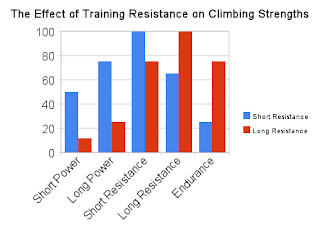- We'll say a climber's base level is the level at which a person climbs quickly(in a day for routes, an hour or so for boulders) when they are fit but haven't performed any intense training.
- The standard level is the level at which a person climbs quickly when a person is benefitting from a training regimen.
- The maximum level is the level at which a person climbs, after training, given a large amount of time.
Now lets look at three common types of climbers.
- The organic climber only trains by climbing. More specifically, this climber only trains by trying a project. The organic climber will try other climbs but only for "fun" and never at a level appropriate to add significant fitness. This climbing style is best suited to a person who wants other interests and lives near a never-ending supply of climbs
- The human climber uses traditional training methods for climbing. This climber holds to the mantra "the best training for climbing is climbing". The human climber trains by doing intervals on routes/boulders, repeating difficult routes, having multiple projects that work different strengths, etc. Cross-training is achieved through running, calisthenics, and other standard fitness builders. This climbing style is suited to someone who wants to perform well in a wide area of climbing and has no interest in boring training.
- The robot climber uses all of the methods of the human climber but adds to them some "advanced techniques". These techniques are what this blog is devoted to. See the workouts page above if you're new. The robot climber thoughtfully combines all of these training methods so that nothing important to the goal is left out. This style of climbing is suited to someone who wants to push their physical limits and redefine what is possible.
Now lets put these ideas together, here is a rough chart showing the three different levels of the three different climbers. For simplicity I've shown the case when all three climbers have the same base level. There is no hard data behind this, these are from observations I've made in the field.

Here are some important things to notice from the above chart. Because of how the organic climber trains his standard level is never much higher than his base level, though his maximum level is a good deal higher than either. The human climber and robot climber have similar standard levels while the robot climber has a significantly higher maximum level. This will play out with the human and robot climber performing similarly on a week or two road trip even though the robot has climbed much harder at home.
We'll end there for today. Next time we'll discuss how to "reset" you base level and how that process differs for the three different climbers.

















